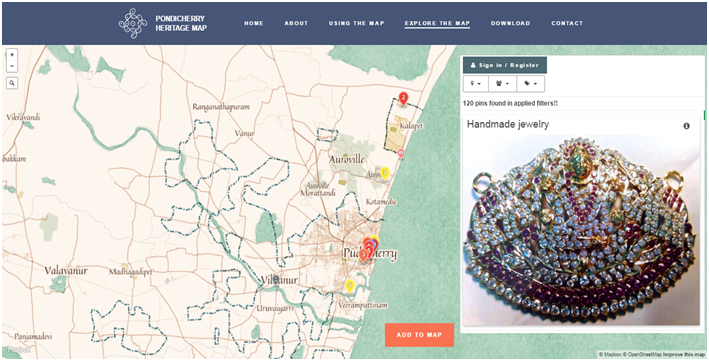Mapping of Intangible Heritage Project – Pondicherry
The ICH Division in association with the Pondicherry Chapter of INTACH is doing a project on mapping of Intangible Heritage in Pondicherry by digitally pinning them on an online map. The first phase of the project was completed successfully with vital additions to the interactive map. This is an ongoing and innovative project. So far 45 new pins has been added and updated to the map which includes a series of 32 street signs with descriptions of how those streets were named, 3 descriptions of built heritage, 10 descriptions of intangible heritage which includes important and interesting information about festivals, local knowledge and craftsmanship. The following is the detail of additions:
This is an ongoing and innovative project which is mostly crowd-sourced. So far many pins have been added and updated to the map which includes a series of 32 street signs with descriptions of how those streets were named, descriptions of built heritage, descriptions of intangible heritage which includes important and interesting information about festivals, local knowledge and craftsmanship.
The pins added to the map include for example:
a series of 32 street signs with descriptions of how those streets were named. For example:
Rue Francois Martin: Governor General Francois Martin is considered to be the ‘founder of Pondicherry’ where he settled as early as 1673, as its first administrator. He was made the first governor general in 1699 and Pondicherry was established as the headquarters of French India in 1701. The urban character of the city began to evolve after he implemented a grid patterned Dutch town plan. Indian weavers and artisans came to settle in Pondicherry due to his initiatives, making it a flourishing trade centre.
descriptions of built heritage:
- the V.O.C. School
- the Small Clock Tower, and
- the Mairie building descriptions of intangible heritage, including:
- Tamil Festival (Veerampatinam Car Festival) and French Festivals (Bastille Day, Armistice Day)
- pins relating to local knowledge and craftsmanship, for example:
Kora Mat Weaving: Mat weaving is one of the earliest known handicrafts and one of the most important practiced in Pondicherry. It was brought to the Villiyanur Commune four generations ago when weavers migrated from Thekkal and Chidambaram, and it is now also practiced commonly in the Kaikalpet, Vanniyar, Rauther and Thuluva Vellalar communities. Across India, mats are weaved with a variety of materials, including jute, coir and bamboo, but in Pondicherry and Tamil Nadu in particular, the kora grass is used. Kora grass grows wild along water bodies and is abundant along the Gingee river and the Kombakkam Lake. The harvested grass is split into two and dried in the sun, which gives it a pale yellow color. Some of the grass is dyed in different shades, which is then woven with the natural grass in patterns of stripes, checks, or floral designs. The craft is traditionally practiced by women in rural communities, and those in Pondicherry work with co-operative societies to purchase the grass at a subsidized rate. Additionally, Pondicherry prisons teach this local trade to inmates as part of their rehabilitation programs.
The goal for the mapping project is to generate more pins using interviews with local people and scholars, focusing on the following themes:
- Festivals
- Ornaments
- Local craftsman
- Performance arts














